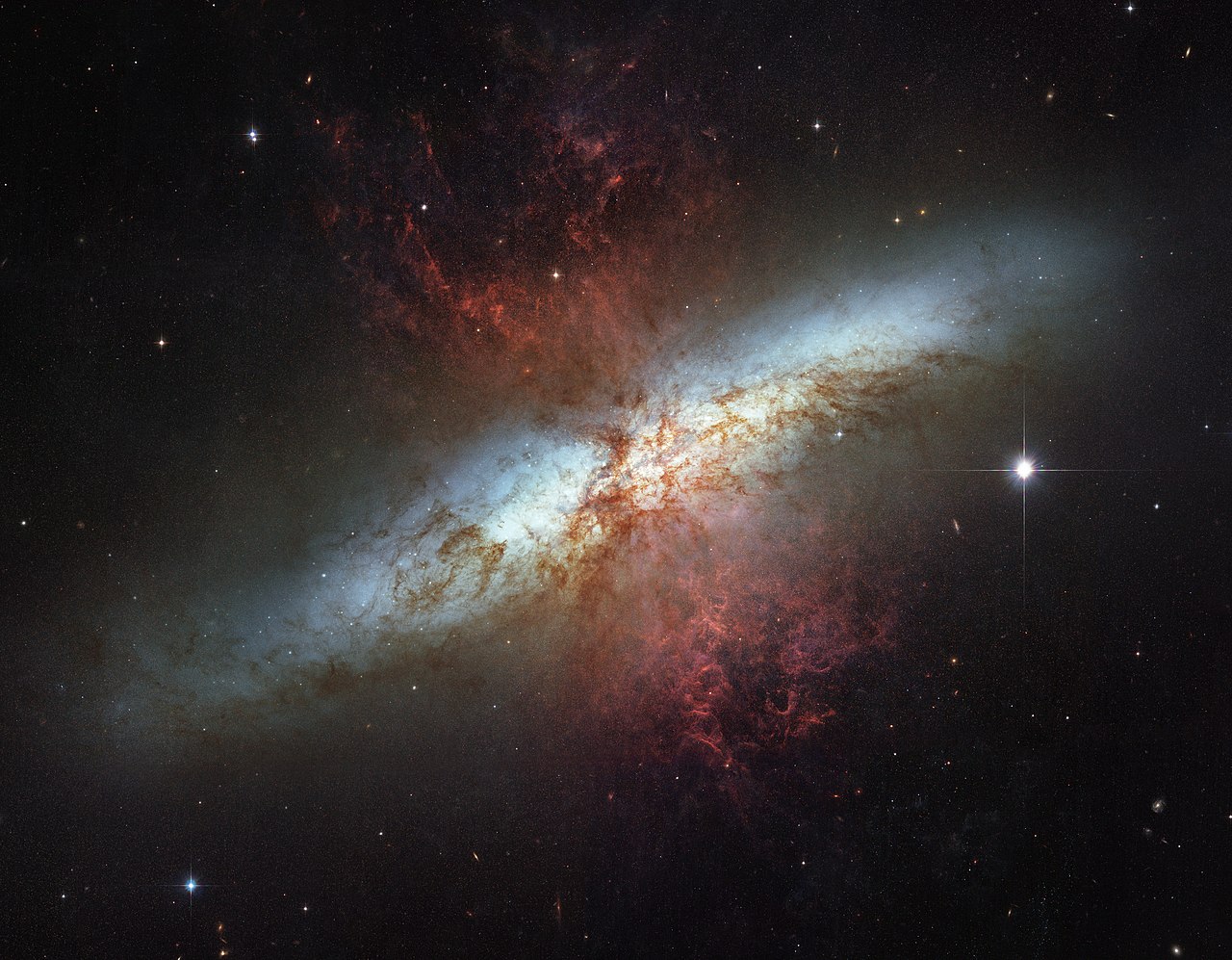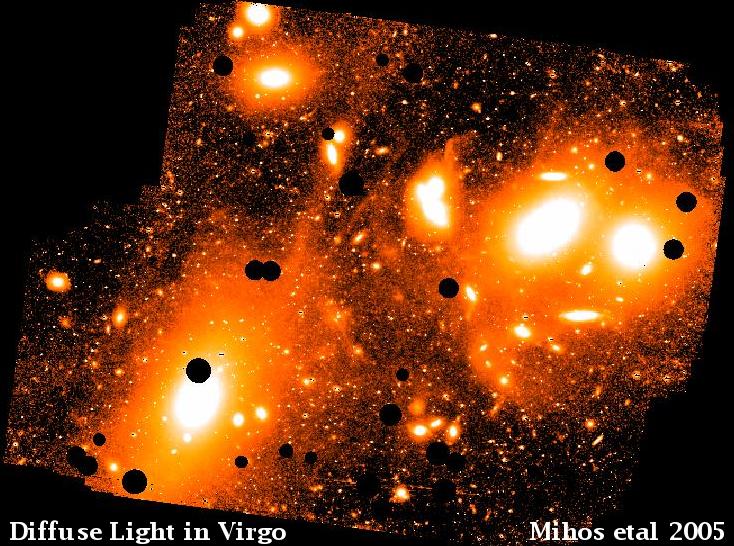In fact, this has been the case for astronomers for well over a decade. Not the panicking, because astronomers are brave and/or apathetic folk, but the missing galaxies. Cosmological models predict far more galaxies than we actually observe. So what happens when all of a sudden you discover a thousand faint galaxies in a nearby cluster ? Throw a massive orgy to celebrate ? No. Well, ye -NO ! You get very puzzled is what you do.
Feel free to scroll down to the "The New Results" section if you like, but if you want the gory details, keep reading.
Modelling the Universe
 |
| Artist's impression of the dark matter (in blue) that is thought to surround the galaxies. |
* Often people claim it's because Edwin Hubble thought that galaxies evolve from smooth "early" to structured "late" type galaxies. Actually, he didn't. In a footnote in his 1926 paper, he basically says that he's using these terms in order to confuse the heck out of everyone.
Sometimes I wonder if we should make peace with astrologers just to let them think up the names.
Anyway, the stars don't just shine, they also spew metal-enriched gas back into the galaxy, at a rate depending on the mass of the star. Very massive stars eject gas much more rapidly than low-mass stars. They're also hotter, so can fuse heavier elements and hence produce more metals.
 |
| Massive "Wolf-Rayet" stars like this one are the drunken louts of the galaxy, projectile-vomiting most of their mass back into interstellar space. Most normal stars are more civilized and just spit a little bit on the interstellar street. |
 |
| The active galaxy M82. |
And I didn't even mention the mysterious dark matter, which we think dominates the mass of the galaxy by around a factor of ten. We think it's there primarily because galaxies are rotating too quickly, which is easiest to explain with a massive amount of unseen matter. That's not the only possible explanation (see, for example, this post), but for today's purposes I'm going to assume dark matter does in fact exist.
As far as we can tell, dark matter doesn't interact through normal matter (or itself) except through gravity. It doesn't radiate heat, it doesn't form stars or planets. By and large, it does bugger all except sit there providing extra mass, at which point I'd be tempted to make a fat-shaming joke if this wasn't now considered offensive.
 |
| Thanks, internet ! |
 |
| The large-scale structure of the Universe : a series of interconnecting filaments of galaxies and clusters of galaxies. |
 |
| The Millennium Simulation. OK, it doesn't look that much like the real Universe, but it would if you put a galaxy in each of the yellow blobs. |
* A dreadful 1980's movie in which a group of PhD students are drawn into an epic race-against-time with a rival group to see who can be the first to simulate the formation of a dwarf galaxy.
Since the simulations use only dark matter, we also have to figure out how much gas and stars we expect to see in each dark matter cloud (normally known as a halo). This is determined in the models largely by the mass of each halo. There is of course some error in this : not all galaxies of the same total mass have the same brightness. Some have most of their mass in gas, some in stars, some have most of their stars more spread out, making them harder to detect. The important point is that the gas and stars aren't simulated, they're only estimated from the model halos. But it still seemed as though the model predicted far too many galaxies.
Weirdly, the model was pretty rubbish around individual galaxies, but seemed to be doing just fine in galaxy clusters - at least at the mass of galaxies it was able to simulate. But we'll get back to that soon.
Observing the Universe
 |
| The aptly-named "Dragonfly" telescope, which has played an important role in discovering new galaxies |
Yes, one of those.
By which I mean, predictably, that it's complicated. What the models predict is how many dwarf galaxies you expect to fine around (say) a giant galaxy like the Milky Way, i.e. within some distance from it. The trouble is that even finding galaxies is difficult. If their stars are too spread out they can be difficult to see; too close together and the whole galaxy can look like a star. Crucially, you have to be able to estimate their distance, otherwise you could be finding galaxies which are much too far away. Measuring distances isn't easy at the best of times, but (like most measurements) it's particularly difficult for the faintest galaxies, which are the most interesting.
You also want your galaxy survey to be uniform. That is, you want it to have the same sensitivity across the whole sky... but part of the sky is unavoidably blocked by the pesky stars of the Milky Way, so you can't do that. Not even if you really want to.
 |
| DAMN THIS CRAPPY MAJESTIC DUST ! |
In any case, the main mechanism proposed to do this is that maybe there are enough supernovae and strong stellar winds to quickly blow out all the gas in dwarf galaxies when they form. That would stop them forming stars later on. The problem is that the dwarf galaxies we know about have a mix of old and young stars, which isn't what that model predicts. More fundamentally, if giant galaxies really are surrounded by lots of invisible dark matter halos, the effect is like being in a swarm of bees : you're gonna get stung. Stinging causes swelling... and that's what doesn't happen to some galaxies. They should have thick stellar discs or central bulges from all those dark halos ploughing through them, but they don't.
 |
| The faint streams of stars indicates that NGC 5907 has torn a smaller satellite galaxy to shreds, but it doesn't have a bulge. |
What about galaxy clusters ?
I said earlier than simulations didn't have a problem for whole clusters, just individual galaxies. The problem there is that that particular paper used the same number of particles for both the simulation of a single galaxy and a cluster. That means the mass of the particles in both simulations won't be the same. If they were, the end result might be different.
 |
| Simulation of a galaxy cluster and an individual galaxy using just dark matter particles. Can you guess which is which ? |
Oh dear. Oh deary deary me.
The New Results
There are actually three papers I want to summarise, but don't worry : they're all quite similar, so I won't go through them all in depth.
We begin with a paper from January : Forty-Seven Milky Way-Sized, Extremely Diffuse Galaxies In The Coma Cluster (the second link goes to an excellent press release). The Dragonfly telescope array (shown above) may be small, but its innovative optics make it excellent at searching for very faint galaxies. And can you guess what it found when researchers pointed it at the Coma cluster ?
 |
| Coma as seen through a more conventional telescope. The new discoveries are much fainter, and difficult to show alongside these brighter galaxies. |
*They weren't looking for them though, because that would have been a remarkable coincidence. Actually they were looking for stars outside their parent galaxies, but found these new galaxies instead.
Although the Milky Way is pathetic in size compared to some of the monster galaxies out there, it's by no means a tiddler. To suddenly find 47 galaxies this big in a region as well-studied as Coma is pretty shocking. The reason they were missed for so many years is that they're of extremely low surface brightness, which just means that they have very few stars for galaxies this large : about a thousand times less than the Milky Way.
You might be wondering how we know these galaxies are really in the cluster, and not closer, smaller objects. Reading the paper it's clear that the team initially thought this was probably the case too. But the new galaxies are distributed in roughly the same way as the known cluster members, which makes that unlikely. Also, by sheer luck, a few of these galaxies happened to appear in archival Hubble observations of known Coma galaxies, which I suppose is a case of cosmic photobombing.
The Hubble observations can't say exactly how far away the galaxies are, but they can place a limit on it. If the galaxies had been slightly closer, the super-sharp Hubble would have been able to pick out individual stars in the new galaxies. It didn't. So the most likely explanation is that they are indeed inside the cluster.
 |
| Hubble image of one of the new galaxies, with some slight contrast adjustment, taken from the paper. |
Still, 47 galaxies isn't anything like the missing tens or hundreds of thousands. Enter paper II : Approximately A Thousand Ultra-Diffuse Galaxies In The Coma Cluster.
 |
| The 8m Subaru telescope is rather larger and more expensive than Dragonfly. |
Determining if nearly a thousand galaxies are in the cluster is considerably more difficult than for a mere 47, but the authors make a very convincing case. Even finding them isn't easy, because for a survey area this large it's not practical to look at the whole thing by eye. Automatic programs have to be used, which cause all sorts of problems : they misidentify other structures as galaxies (like artifacts in the data and stellar streams) and can identify real galaxies which aren't in the cluster at all. So the team went through all the candidate galaxies the program found, carefully checking to make sure it was really finding galaxies and not something less interesting like some stupid graduate student's fingerprints on the lens.
The most compelling argument is that when they looked in a field outside of the cluster, and did all their very careful processing, they didn't find a single candidate galaxy. As with one of the galaxies found with Dragonfly, they also have a redshift measurement of one galaxy that confirms it's a cluster member. So it's pretty safe to assume that the majority of these detections really are in the cluster.
But a thousand galaxies still isn't enough. Not by a long shot.
Enter paper III : Probing The Low Surface Brightness Dwarf Galaxy Population Of The Virgo Cluster. The lead author is my PhD supervisor, so obviously that means this one is far better than those other two papers, which are really pretty crappy amateurish ramblings when you think about it.
Actually what this does do that the others don't is try to quantify just exactly how bad the missing satellite problem is. This one looks at the closer Virgo cluster rather than Coma, using archival data from the Next Generation Virgo Survey.
The paper goes into a lot of details about how they find the galaxies, which is complicated. There are hints that the ~300 new galaxies they find are by no means all that's there, but they doubt there could be orders of magnitude more lurking in the data. Interestingly, the galaxies they find in Virgo are all much smaller than the faint giant galaxies found in Coma*. That raises another issue since the Coma cluster is thought to be older and more evolved, whereas Virgo is still being assembled. How, then, have those faint wispy galaxies survived there without being torn apart ? It would make more sense in Virgo where they could be falling in to the cluster for the first time.
*The authors tell me that this could be because of how the data was processed by the original observing team. There could be larger galaxies hiding in the data, but we won't know until the raw data is released and re-processed in a way more suitable for finding large, faint objects.
Galaxy clusters are undoubtedly very dangerous places to be. Super-sensitive observation of Virgo revealed a dramatic image of streaky structures in the very outermost parts of the galaxies, likely due to the other galaxies disrupting their stars :
 |
| Intracluster light, with the foreground stars of our own Galaxy masked as black circles. |
What I mean by this is : what is the total mass of the galaxies ? A "huge dwarf" (my term) would be a galaxy with the same mass in stars and dark matter but just much more extended than "normal" dwarfs. Basically, imagine taking Gimli and inserting an air pump so that his size increases but his mass stays the same, sort of like the Mr Creosote sketch...
Actually don't imagine that because it's a horrible mental image, but you get the idea.
If, on the other hand, the galaxies have a lot of dark matter (so a total mass much greater than dwarfs), this would make them faint giants (sometimes called "crouching giants"). We don't yet have the observations needed to say which of these is correct, but this second possibility does offer an explanation as to how they've survived.
Being massive would make them much more difficult to disrupt, which would explain why they've survived and they all look nice and smooth. Of course if they're too massive then they wouldn't explain the missing satellite problem at all, and we might even end up having far too many massive galaxies. We'll have to wait for new observations to estimate their total masses before we can try and answer this one.
For the galaxies in Virgo, which are much smaller, this scenario is not likely or necessary (since they could just be falling in for the very first time). The analysis shows that, when correcting as much as possible for the various sources of error, there are nowhere near enough galaxies in the cluster as the cosmological models predict. So in Virgo, at least, the missing satellite problem is still a problem, and everyone is still very embarrassed.
Summary
Galaxy formation models have many problems, not least in predicting the number of galaxies we expect to find. They predict we should see far more than we actually do. But the devil's in the details... and it looks like these new discoveries aren't nearly enough to solve the problem. They might, conceivably, make things even worse.
But it's also extremely important to remember just how complicated galaxy simulations need to be, which is why I rambled on about it at great length. We're not even at the stage where we can include all the physical processes we know about - computers are nowhere near powerful enough for that.
Some people would like to use the old axiom, "if it disagrees with observation it is wrong" to say that the whole idea of dark matter-cosmology is fundamentally wrong. The problem is that the simulations are so woefully incomplete that this makes no sense, because we're not even at the stage of being able to say if they're wrong. They might be, that is perfectly possible. But it's ridiculous to claim that we know for certain that that is the case right now.
What I like most about these papers is how much they expose our tremendous ignorance. Suddenly : BAM ! A thousand new galaxies in the Coma cluster, just like that. And not just any sort of galaxies, but a population of objects we thought were extremely rare. No-one had used galaxy formation theories to predict that there should be a huge number of galaxies as big as the Milky Way but a thousand times fainter hiding in some clusters but (perhaps) not others. For the moment, our observations are running well ahead of our theories. If you're hoping that scientists will come up with any sort of grand, profound understanding of the cosmos, I'm afraid you're going to be waiting for a very long time yet.




Hi Rhys, is it currently possible to measure stellar motions within these "dark galaxies" to construct rotation curves, or carry out spectroscopic observations ?
ReplyDeleteI'll have to check the papers but at least a couple do have redshift measurements. However I don't think they have good enough measurements (e.g. long slit spectroscopy) to determine rotation curves. This would be difficult because the things are so faint, though I don't know enough about it to say quantify how difficult it would be.
DeleteA very few of the galaxies in Virgo do have HI detections, so with the VLA it might be possible to construct a rotation curve but no-one's done this yet. I can think of one of them off the top of my head because it happened to be in an AGES cube and already detected in a previous deep optical survey. IIRC it had very high gas content compared to its stellar mass. The weird thing is that there's this one gas rich object but many similar objects which apparently don't have any gas at all.